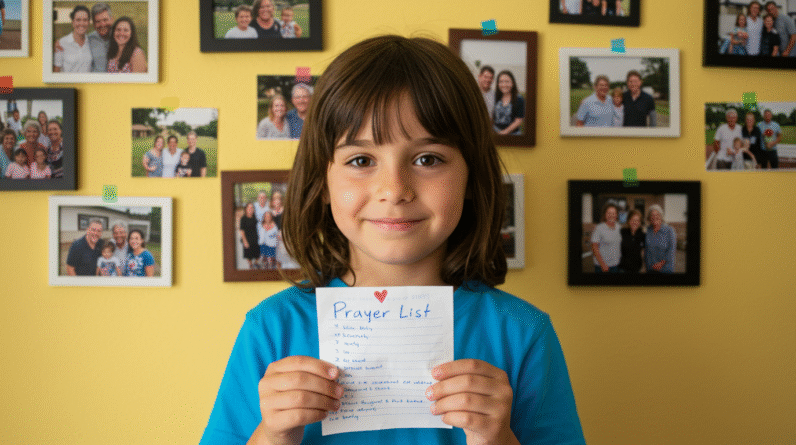Faith Conversations With Your Kids: How And When To Start
The thought of discussing faith with your children might feel as intimidating as climbing a mountain. Yet, just as a mountain trek begins with a single step, so does the journey into faith conversations with kids. These discussions, however daunting, can profoundly shape their understanding of the world and, ultimately, their place within it. But how do you begin? How can you weave complex concepts like God, sin, grace, and salvation into the daily fabric of your child’s life? Worry not—this guide is here to help you navigate the ‘how’ and ‘when’ of these crucial conversations.
Why Start Faith Conversations with Kids?
You might wonder, why should you bother with these discussions now? Can’t they just figure it out when they’re older? Well, talking about faith provides children with a strong foundation to interpret life’s joys and challenges. When you engage in faith conversations with kids, you’re offering them a lens through which they can view the world.
Discussing faith isn’t solely about imparting religious doctrine. It’s about nurturing a space for your kids to ask questions, express doubts, and articulate their evolving understanding of spiritual matters. This dialogue demonstrates that faith is a living, breathing element of life—not something relegated to Sundays or religious holidays.
When to Start: Timing and the Basics
Timing is everything in parenting, and faith conversations are no exception. Start early, but not too early. You might begin when your child starts asking questions about their surroundings—that’s an indicator that they’re ready to explore more abstract themes. Though there’s no one-size-fits-all answer, tailoring discussions to your child’s cognitive and emotional development can guide you.
Ages 3-5: Planting Seeds
Children at this age are natural-born explorers. Their endless questions might already have you fielding a flurry of “why” and “how” inquiries. This curious nature makes it an ideal time to introduce basic concepts. Let stories be your ally. Bible stories serve as an engaging and accessible entry point. Instead of abstract theological principles, illustrate ideas through narratives that capture their imagination. Adam and Eve, Noah’s Ark, and the birth of Jesus are timeless tales that can lay the groundwork.
Ages 6-9: Building Blocks
Now that the seeds are planted, it’s time to nurture them. This age group has a budding ability to understand more layered concepts. They still enjoy stories, so continue leaning on parables and biblical narratives (Luke 15:11-32—The Prodigal Son, for instance). Introduce simple ideas of right and wrong within the context of grace and salvation. Emphasize that questions are welcome; curiosity is the authenticity of faith.
Ages 10-12: Deepening Understanding
Your pre-teens are beginning to grapple with identity and the world around them. This stage is ripe for deeper discussions about how faith plays a role in life choices and ethics. Open dialogues about more complex topics like sin or forgiveness. Approach these conversations with openness to foster a safe environment for them to voice their thoughts. Collaborate on interpretations, allowing them to draw connections between biblical stories and their own experiences.
How to Approach Faith Conversations
Approaching faith conversations with kids doesn’t need a formulaic strategy, but certain approaches can assist in making these exchanges impactful and meaningful.
Be a Living Example
Children learn more from observing than listening. Let your life reflect your beliefs authentically. If your kids see you embody values of kindness, love, patience, and humility, they’ll more clearly understand what faith in action looks like. Admitting failures and modeling vulnerability (perhaps when you’re struggling with doubt or questions) can humanize the concept of faith, teaching them that no one is infallible.
Create an Environment for Open Dialogue
Establish a regular routine with your kids that includes time for faith-based conversations. Maybe it’s during dinner, a quiet time just before bed, or during car rides. The goal is to foster a space where exploring faith feels normal and comfortable. When your child expresses an opinion or query, listen fully. Show genuine interest in their perspective, even if it challenges yours. Praise them for their courage to share and reinforce that all thoughts are valid.
Encourage the Questioning Mind
Questions are the entrance to understanding. Encouraging your children to question elements of faith fosters critical thinking and a more profound connection to their beliefs. For shy kids or those unsure about asking questions, invite them to write their questions down. This practice can help them articulate their thoughts without the pressure of verbal interaction. If ever stumped by a difficult question, don’t hesitate to say, “I don’t know.” Looking for answers together can be a bonding experience.
Use Everyday Moments
The most impactful conversations can happen when you’re least expecting them. Use the day-to-day to touch on faith principles. Discuss the significance of gratitude when witnessing a beautiful sunset or talk about generosity while helping a neighbor. These moments are natural springboards for introducing bigger themes in a context they can relate to.

Modeling Vulnerability and Handling Tough Questions
Faith conversations with kids will inevitably bring forth tough questions—even those you might not have answers to. You may find yourself grappling with questions like “Why do bad things happen if God is good?” or “What happens after we die?” These existential queries are daunting but represent teachable moments.
Acknowledge Complexity
Admit when a topic is complex. It’s okay for your child to see that you, too, ponder the big questions. When you acknowledge the uncertainty, you’re embodying a faith deeply rooted in hope rather than certainty. Reflect together on what the Bible offers as interpretations (Romans 8:28).
Seek Knowledge Together
Start by exploring biblical texts or religious resources together to find possible answers. This approach demonstrates that faith isn’t stagnant but evolves with inquiry, study, and understanding. Emphasizing the continuous journey of learning can be both comforting and inspiring for kids.
Discuss the Role of Other Perspectives
Make space for other perspectives. Faith is personal yet enriched by collective experience. Encourage kids to engage with different viewpoints. Allow them to see the beauty in diversity of thought, reinforcing that faith is enriched by questioning and varied interpretations.
Incorporating the Bible into Conversations
The Bible can be an excellent resource for illustrating faith with real examples. Approaching scripture does not need to be intimidating. Here’s how to effectively incorporate the Bible into your conversations.
Start Simple and Relatable
Begin with shorter, relatable passages that convey strong messages (Matthew 22:36-40—The Greatest Commandment). These verses are easy to memorize and carry messages that can be applied to everyday life. Discuss what the passages mean in a modern context and how they apply to your child’s experiences.
Storytelling Approach
Use a storytelling approach to convey biblical events, turning them into engaging stories that capture your child’s attention. Listen to audio Bibles or dwell together over illustrated scripture books designed for younger audiences. When storytelling is interactive and fun, it feels less like a lesson and more like an adventure.
Connect to Today’s World
Draw parallels between biblical stories and today’s world to make the scripture more accessible. How do parables about community and helping those in need resonate with what your child sees at school or in the neighborhood? Making these connections cultivates empathy and practical understanding.
Advanced Topics: Grace, Sin, and Salvation
As you delve deeper into faith conversations with your kids, you’ll encounter themes like grace, sin, and salvation. While nuanced, these concepts can be simplified into kid-friendly discussions.
Demystifying Sin
Children have an innate sense of fairness. Begin by contextualizing sin as actions that harm others or oneself, connecting them to behaviors they should avoid (e.g., lying, being selfish). Frame these discussions with the motivating principle of love rather than fear, emphasizing that it’s normal to make mistakes, and improvements are always possible.
Grace as the Gift
Help your child understand grace as the beautiful act of receiving love and forgiveness, even when undeserved (Ephesians 2:8-9). Engage them in activities that involve extending grace—whether it’s showing kindness to a sibling after a quarrel or donating toys for kids in need.
Understanding Salvation
Discuss salvation by explaining how Jesus’ life and teachings lead us to live in connection with God (John 3:16). Clear up misconceptions by relating the concept of altruism—performing acts that benefit others without expecting anything in return.

Overcoming Challenges in Faith Conversations
It won’t all be smooth sailing. You may face resistance, distraction, or emotional barriers. Here’s how to overcome these challenges.
Navigate Resistance with Patience
It’s possible your child might resist or seem disinterested. Be patient and don’t force conversations. Their faith journey will develop at its own pace. Use informal ways to keep these discussions light. Maybe a creative activity or a faith-based game will spark interest.
Distraction as a Tool
Infuse faith themes subtly into activities they enjoy. If they’re captivated by nature, discuss God’s creation during hikes. For artistically inclined children, use drawings to explore biblical themes.
Acknowledging Their Emotional World
Some kids harbor complex emotional landscapes. Be sensitive to their feelings, especially during tough conversations like death or suffering. Validate their emotions and reinforce that it’s normal to feel a range of feelings about faith.
Nurturing a Lifetime and Legacy of Faith
As your child grows and eventually becomes independent, know that the seeds of faith you’ve sown have the potential to blossom into a lifelong journey within them. Each conversation builds capital—the intellectual, emotional, and spiritual wool they’ll wear as adults.
When engaging in faith conversations with kids, remember they’re not just about imparting belief. They’re about creating a space where reflective thought and love can blossom. It’s about sharing the journey you’ve embarked on, fostering a mutual exploration where questions are the markers showing you where you’ve been and where you’re going together.
Explore More
For further reading and encouragement, check out these posts:
👉 7 Bible Verses About Faith in Hard Times
👉 Job’s Faith: What We Can Learn From His Trials
👉 How To Trust God When Everything Falls Apart
👉 Why God Allows Suffering – A Biblical Perspective
👉 Faith Over Fear: How To Stand Strong In Uncertain Seasons
👉 How To Encourage Someone Struggling With Their Faith
👉 5 Prayers for Strength When You’re Feeling Weak

📘 Jesus and the Woman Caught in Adultery – Grace and Mercy Over Judgement
A powerful retelling of John 8:1-11. This book brings to life the depth of forgiveness, mercy, and God’s unwavering love.
👉 Check it now on Amazon
As a ClickBank Affiliate, I earn from qualifying purchases.
Acknowledgment: All Bible verses referenced in this article were accessed via Bible Gateway (or Bible Hub).
“Want to explore more? Check out our latest post on Why Jesus? and discover the life-changing truth of the Gospel!”








